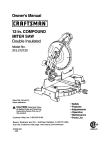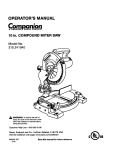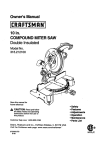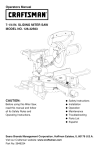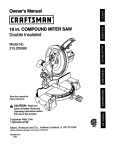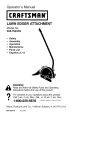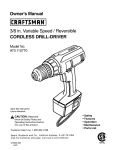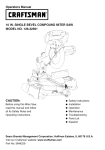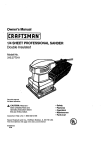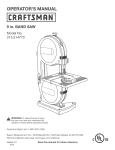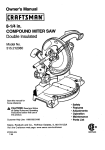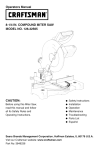Download Craftsman 315.21211 Saw User Manual
Transcript
Owner's Manual
10 in.
COMPOUND MITER SAW
Double Insulated
Model No.
315.212110
Save this manual for
future reference
•
•
•
•
•
•
CAUTION: Read and follow
all Safety Rules and Operating
Instructions before first use of
this product.
Customer
Sears,
Help Line: 1-800-932-3188
Roebuck
Visit the Craftsman
972000-744
2-00
and
Co.,
Hoffman
web page:
Estates,
IL 60179
www.sears.com/craftsman
USA
Safety
Features
Adjustments
Operation
Maintenance
Parts List
•
Table of Contents
...........................................................................................................................................
•
Warranty
•
Rules For Safe Operation
•
Glossary
•
Product
•
Labels .............................................................................................................................................................
8
•
Loose Parts and Tools Needed ......................................................................................................................
9
•
Features ..................................................................................................................................................
10-12
•
Adjustments
.............................................................................................................................................
13-19
•
Operation
.................................................................................................................................................
20-26
•
Maintenance
•
Exploded View and Repair Parts List ......................................................................................................
•
Parts Ordering
and Introduction
2
..............................................................................................................................
...........................................................................................................................
2
3-6
.........................................................................................................................................................
Specifications
and Unpacking
..........................................................................................................
............................................................................................................................................
/ Service
.....................
6
7
27-26
30-37
.'.........................................................................................................
38
FULL ONE YEAR WARRANTY
If this product fails due to a defect in material or workmanship within one year from the date of purchase,
Sears will repair it free of charge.
Contact a Sears Service Center for repair.
If this product is used for commercial or rental purposes, this warranty applies only for 90 days from the date
of purchase.
This warranty gives you specific legal rights, and you may also have other rights which vary from state to statel
Sears, Roebuck and Co., Dept. 817WA, Hoffman Estates, IL 60179
Your saw has many features for making cutting
operations more pleasant and enjoyable. Safety,
performance and dependability have been given top
priority in the design of this saw making it easy to
maintain and operate.
A_, Look for this symbol to point
Your safety is involved.
_,
out important
_,
safety
CAUTION: Carefully read throughthis entire
owner's manual before using your new saw. Pay
close attention to the Rules For Safe Operation,
and all Safety Alert Symbols including Danger,
Warning and Caution, If you use your saw
properly and only for what it is intended, you will
enjoy years of safe, reliable service.
precautions.
It means
attention!H
WARNING:
The operation ol any power tool can result in foreign objects being thrown into your eyes,
which can result in severe eye damage. Before beginning power tool operation, always
wear safety goggles or safety glasses with side shields and a fulr face shield when needed.
We recommend Wide Vision Safety Mask for use over eyeglasses or standard safety
glasses with side shields, available at Sears Retail Stores.
The purpose of safety symbols is to attract your attention to possible dangers. The safety symbols, and
the explanations with them, deserve your careful attention and understanding. The safety warnings do
not by themselves eliminate any danger. The instructions or warnings they give are not substitutes for
proper accident prevention measures.
SYMBOL
A
MEANING
SAFETY ALERT SYMBOL:
Indicates danger, warnmg or caution. May be used in conjunctionwith other symbolsor picto°
graphs.
A
DANGER: Failure to obey a safety warning will result in serious injury to yourself or to others.
Always follow the safety precautions to reduce the risk of fire, electric shock and personal injury.
WARNING: Failure to obey a safety warning can result in serious injury to yourself or to others.
Always follow the safety precautions to reduce the risk of fire, electric shock and personal injury.
zL
CAUTION:
Failure to obey a safety warning may result in property damage or personal injury to
yourself or to others, Always follow the safety precautions to reduce the risk of fire, electric shock
and personal injury.
NOTE:
Advises you of information or instructions vital to the operation or maintenance of the equipment.
DOUBLE
INSULATION
IMPORTANT
Double insulation is a concept in safety, in electric
power tools, which eliminates the need for the usual
three-wire grounded power cord. All exposed metal
parts are isolated from internal metal motor
components with protecting insulation. Double
insulated tools do not need to be grounded.
,_.
Servicing requires extreme care and knowledge of the
system and should be performed only by a qualified
service technician. For service we suggest you return
the tool to your nearest Sears store for repair. Always
use original factory replacement parts when servicing.
KEEP THE WORK AREA CLEAN. Cluttered work
areas and work benches invite accidents. DO
NOT leave tools or pieces of wood on the saw
while it is in operation.
WARNING: Do not attempt to operate this tool
until you have read thoroughly and understand
completely all instructions, safety rules, etc.
contained in this manual Failure to comply can
result in accidents involving fire, electric shock,
or serious personal injury. Save owner's manual
and review frequently for continuing safe
operation, and instructing others who may use
this tool.
READ
ALL
DO NOT USE IN DANGEROUS ENVIRONMENTS. Do not use power tools near gasoline or
other flammable liquids, in damp or wet locations,
or expose them to rain. Keep the work area well
lit.
INSTRUCTIONS
KEEP CHILDREN
KNOW YOUR POWER TOOL.
Read the owner's
manual carefully. Learn the saw's applications
and limitations as well as the specific potential
hazards related to this tool.
•
•
REMOVE
DO NOT FORCE THE TOOL. It will do the job
better and safer at the rate for which it was
designed.
IN PLACE and in good working
ADJUSTING
AWAY. All
MAKE WORKSHOP CHILD-PROOF with padlocks and master switches, or by removing starter
keys.
GUARD AGAINST ELECTRICAL
SHOCK BY
PREVENTING
BODY CONTACT WITH
GROUNDED
SURFACES. For example; pipes,
radiators, ranges, refrigerator enclosures.
KEEP GUARDS
order.
AND VISITORS
visitors shoutd wear safety glasses and be kept a
safe distance from work area. Do not let visitors
contact tool or extension cord while operating.
USE THE RIGHT TOOL. Do not force the tool or
KEYS AND
attachment to do a job it was not designed
Don't use it for a purpose not intended.
WRENCHES.
Get in the habit of checking to see
that hex keys and adjusting wrenches are
removed from tool before turning on saw
3
for.
RULES
FOR
SAFE
OPERATION
(Continued)
USE THE PROPER EXTENSION CORD. Make
sure your extension cord is in good condition.
When using an extension cord, be sure to use
one heavy enough to carry the current your
product will draw. An undersized cord will cause
a drop in line voltage resulting in loss of power
and overheating. A wire gage size (A.WG.) of at
least 14 is recommended
for an extension cord
function. Check for alignment of moving parts,
binding of moving parts, breakage of parts,
mounting and any other conditions that may
affect its operation. A guard or other part that is
damaged must be properly repaired or replaced
by a qualified service technician at a Sears store
to avoid risk of personal injury.
NEVER LEAVE TOOL RUNNING UNATTENDED. TURN THE POWER OFF. Do not
leave tool until it comes to a complete stop.
25 feet or less in length. If in doubt, use the next
heavier gage. The smaller the gage number, the
heavier the cord.
INSPECT
CALLY
EXTENSION
CORDS
FIRMLY CLAMP OR BOLT your miter saw to a
workbench or table at approximately
hip height.
PERIODI-
and replace if damaged.
USE ONLY CORRECT BLADES. Do not use
blades with incorrect size holes. Never use blade
washers or blade bolts that are defective or
incorrect. The maximum blade capacity of your
saw is 10 in.
DRESS PROPERLY. Do not wear loose clothing,
gloves, neckties, rings, bracelets, or other
jewelry. They can get caught and draw you into
moving parts. Rubber gloves and nonslip footwear are recommended
when working outdoors.
Also wear protective hair covering to contain long
hair.
•
•
ALWAYS WEAR SAFETY GLASSES WITH
SIDE SHIELDS. Everyday eyeglasses have only
impact-resistant lenses; they are NOT safety
glasses.
PROTECT YOUR LUNGS. Wear a face or dust
mask if the cutting operation is dusty.
•
PROTECT YOUR HEARING. Wear hearing
protection during extended periods of operation.
•
SECURE WORK. Use clamps or a vise to hold
work when practical. It's safer than using your
•
•
•
hand and it frees both hands to operate tool.
DO NOT OVERREACH. Keep proper footing and
balance at a_Ltimes.
ALL TOOLS.
AVOID ACCIDENTAL
STARTING.
switch is off when plugging
•
USE RECOMMENDED
•
Be sure
in.
ACCESSORIES.
use of improper accessories
injury.
•
The
DAMAGED
DO NOT REMOVE THE SAW'S BLADE
GUARDS. Never operate the saw with any guard
or cover removed. Make sure all guards are
operating properly before each use.
•
KEEP HANDS AWAY FROM CUTTING AREA.
Keep hands away from blades. Do not reach
underneath work or around or under the blade
while blade is rotating. Do not attempt to remove
cut material when blade is moving.
PARTS.
WARNING:
Blade coasts after turn off.
•
DO NOT ABUSE CORD. Never yank cord to
disconnect it from receptacle. Keep cord from
heat, oil, and sharp edges.
•
INSPECT TOOL CORDS PERIODICALLY and if
damaged, have repaired by a qualified service
technician at a Sears store. Stay constantly
aware of cord location and keep it well away
from the rotating blade
•
USE OUTDOOR EXTENSION CORDS. When
tool is used outdoors,use only extension cords
with approved ground connection that are
intended for use outdoors and so marked.
DO NOT USE TOOL IF SWITCH DOES NOT
TURN IT ON AND OFF. Have defective switches
replaced by a qualified service technician at a
Sears store.
may cause risk of
NEVER STAND ON TOOL. Serious injury could
occur if the tool is tipped or if the blade is
unintentionally contacted.
CHECK
•
When not in use,
before servicing, or when changing attachments,
blades, bits, cutters, etc., all tools should be
disconnected.
•
KEEP BLADES CLEAN, SHARP AND WITH
SUFFICIENT SET. Sharp blades minimize
stalling and kickback.
_1,
MAINTAIN TOOLS WITH CARE. Keep tools
sharp and clean for better and safer performance. Follow instructions for lubricating and
changing accessories.
DISCONNECT
•
KEEP TOOL DRY, CLEAN, AND FREE FROM
OIL AND GREASE. Always use a clean cloth
when cleaning. Never use brake fluids, gasoline,
petroleum-based products, or any solvents to
clean tool.
Before further use
of the tool, a guard or other part that is damaged
should be carefully checked to determine that it
will operate properly and perform its intended
4
RULES
FOR SAFE
ALWAYS
SUPPORT
OPERATION
(Continued)
LONG WORKPIECES
to
•
minimize risk of blade pinching and kickback,
Saw may slip, walk, or slide while cutting long or
heavy boards.
OPERATIONS
AND HAND
POSITIONS where a sudden slip could cause
your hand to move into the blade. ALWAYS
make sure you have good balance. NEVER
operate your miter saw on the floor or in a
crouched position.
BEFORE MAKING A CUT, BE SURE ALL
ADJUSTMENTS
ARE SECURE.
AVOID CUTTING NAILS. Inspect for and
remove all nails from lumber before cutting.
•
NEVER stand or have any part of your body in
line with the path of the saw blade.
ALWAYS USE A CLAMP to secure the work-
•
ALWAYS release the power switch and allow the
saw blade to stop rotating before raising it out of
the workpiece.
•
DO NOT TURN THE MOTOR SWITCH ON AND
OFF RAPIDLY. This could cause the saw blade
to loosen and could create a hazard. Should this
ever occur, stand clear and allow the saw blade
to come to a complete stop. Disconnect your saw
from the power supply and securely retighten the
blade bolt.
piece when possible.
•
NEVER TOUCH
during use.
•
NEVER START A TOOL WHEN THE BLADE IS
IN CONTACT WITH WORKPIECE.
Allow motor
BLADE or other moving parts
to come up to full speed before starting cut.
•
AVOID AWKWARD
MAKE SURE THE MITER TABLE
AND SAW
ARM (BEVEL FUNCTION) ARE LOCKED IN
POSITION BEFORE OPERATING
YOUR SAW.
Lock the miter table by securely tightening the
miter lock handle. Lock the saw arm (bevel
function) by securely tightening the bevel lock
knob.
NEVER
SCRAP
USE A LENGTH STOP ON THE FREE
END OF A CLAMPED WORKPIECE.
NEVER hold onto or bind the free scrap end of
the workpiece in any operation. If a work clamp
and length stop are used together, they must
both be installed on the same side of the saw
table to prevent the saw from catching the loose
end and kicking up
NEVER cut more than one piece at a time. DO
NOT STACK more than one workpiece on the
saw table at a time.
•
NEVER PERFORM ANY OPERATION
"FREEHAND". Always place the workpiece to be cut on
the miter table and position it firmly against the
fence as a backstop. Always use the fence.
•
NEVER hand hold a workpiece that is too small
to be clamped. Keep hands clear of the no hands
zone.
NEVER
REPLACEMENT
PARTS. Allrepairs, whether
electrical or mechanical, should be made by
qualified service technician at a Sears store.
A
WARNING: When servicing use only identical
Craftsman replacement parts. Use of any other
parts may create a hazard or cause product
damage.
•
NEVER USE IN AN EXPLOSIVE
SPHERE. Normal sparking
ignite fumes.
•
while
to a power source.
POLARIZED PLUGS. To reduce the risk of
electric shock, this tool has a polarized plug (one
blade is wider than the other ) . This plug will fit in
a polarized outlet only one way. If the plug does
not fit fully in the outlet, reverse the plug. If it still
does not fit, contact a qualified electrician to
install the proper outlet. Do not change the plug
in any way.
•
IF ANY PART OF THIS MITER SAW IS MISSING or should break, bend, or fail in any way, or
should any electrical component fail to perform
properly, shut off the power switch, remove the
miter saw plug from the power source and have
damaged, missing, or failed parts replaced
before resuming operation.
reach behind, under, or within three
inches of the blade and its cutting path with your
hands and fingers for any reason.
NEVER reach to pick up a workpiece, a piece of
scrap, or anything else that is in or near the
cutting path of the blade.
of the motor could
NEVER leave the miter saw unattended
connected
•
ATMO-
•
DO NOT OPERATE THIS TOOL WHILE UNDER THE INFLUENCE OF DRUGS, ALCOHOL,
OR ANY MEDICATION.
RULES
•
FOR SAFE
OPERATION
(Continued)
ALWAYS STAY ALERT! Do not allow familiarity
(gained from frequent use of your saw) to cause
a careless mistake. ALWAYS REMEMBER that
a careless fraction of a second is sufficient to
inflict severe injury.
111 MAKE SURE THE WORK AREA HAS AMPLE
LIGHTING to see the work and that no obstructions will interfere with safe operation BEFORE
performing any work using your saw,
ALWAYS TURN OFF SAW before disconnecting
it, to avoid accidental starting when re-connecting to power supply.
STAY ALERT AND EXERCISE CONTROL.
Watch what you are doing and use common
sense. Do not operate tool when you are tired,
Do not rush.
SAVE THESE INSTRUCTIONS. Refer to them
frequently and use to instructother users. If you
loan someone this tool, loan them these instructions also.
SAVE THESE INSTRUCTIONS
Arbor
The shaft on which a blade or cutting tool is mounted.
Set
The distance that the tip of the sawblade tooth is bent
(or set) outward from the face of the blade.
Throw-Back
Bevel Cut
A cutting operation made with the blade at any angle
other than 90 ° to the miter table.
Throwing of a workpiece in a manner similar to a
kickback. Usually associated with a cause other than
the kerr closing, such as a workpiece not being
against the fence, being dropped intothe blade, or
being placed inadvertently in contact with the blade,
Crosscut
A cutting or shaping operation made across the grain
of the workpiece.
Compound Miter Cut
A compound miter cut is a cut made using a miter
angle and a bevel angle at the same time.
Freehand
Through Sawing
Any cutting operation where the blade extends
completely through the thicknessof the workpiece.
Performing a cut without using a fence, miter gage,
fixture, work clamp, or other proper device to keep the
workpiece from twisting or moving during the cut.
Gum
Workpiece
The item on which the cuttingoperation is being done.
The surfaces of a workpiece are commonly referred to
as faces, ends, and edges.
A sticky, sap based residue from wood products.
Miter Cut
Zero Clearance Throat Plate
A plastic throat plate inserted in the miter table that
allows for blade clearance. When you make your first
cut with your compound miter saw, the saw blade cuts
a slot through the throat plate the exact widthof the
blade. This providesfor a zero clearance kerr that
minimizes workpiece tear-out.
No Hands Zone
The area between the marked lines on the left and
right side of the miter table base. This zone is
identified by no hands zone labels placed inside the
marked lines on the miter table base.
A cutting operation made with the blade at any angle
other than 90 ° to the fence.
Resin
A sticky, sap base substance that has hardened.
Revolutions Per Minute (RPM)
The number of turns completed by a spinningobject
in one minute.
Saw Blade Path
The area over, under, behind, or in front of the blade.
As it applies to the workpiece, that area which will be,
or has been, cut by the blade.
6
Blade Diameter
Blade Arbor
No Load Speed
Rating
Input
10 in.
Cutting Capacity
5/8 in.
0°:
5-9/16 in. wide X 2-9/32 in. thick
3-9/16 in. thick X 4 in. wide
5000 RPM
Maximum
120 Volts, 60 Hz-AC Only
Cutting Capacity with Miter at 45"/Bevel
0°:
3-15/16 in. wide X 2-9/32 in. thick
15 Amperes
Net Weight
with Miter at 0°/Bevel
Maximum
32 Ibs.
Cutting Capacity
with Miter at 0_'/Bevel 45°:
5-9/16 in. wide X 1-9/16 in. thick
Maximum
Cutting Capacity with Miter at 45°/Bevel
45°:
4 in. wide X 1-9/16 in, thick
Your Compound Miter Saw has been shipped
completely assembled except for the blade, miter lock
handle, and dust guide.
Do not discard the packing materials until you
have carefully inspected the saw, identified all
loose parts, and satisfactorily operated your new
saw.
_k
WARNING:
If any parts are missing, do not
operate this tool until the missing parts are
replaced. Failure to do so could result in possible
serious personal injury.
•
Your saw has been shipped with the saw arm
locked in the down position. To release saw arm,
push down on top of saw arm and pull out the lock
pin. See Figure 4.
•
Remove all loose parts from the carton. Separate
and check with the list of loose parts. See Figure 2.
•
•
Remove the packing materials from around your
saw.
Lift the saw arm by the handle. Hand pressure
should remain on the saw arm to prevent sudden
rise upon release of the lock pin.
•
Examine all parts to make sure no breakage or
damage has occurred during shipping.
Carefully lift saw from the carton and place it on a
level work surface. This saw is heavy. To avoid
back injury, get help when needed.
If any parts are damaged or missing, do not attempt to
plug in the power cord and turn the switch on until the
damaged or missing parts are obtained and are
installed correctly.
7
The following labels are on the miter saw with locations indicated.
DANGER: OO NOT REMOVE
ANY GUARD. USE OF SAW
WITHOUT THIS GUARD WILL
RESULT IN SERIOUS INJURY.
,A WARNING/ ADVERTENCIA
• For your safety, read owners manual before operating
miter saw.
• Wear eye protection.
• Keep hands out of path of saw blade.
• Do not operate saw without guards in place.
• Do not perform any operation freehand.
• Never roach around the saw blade.
• "rumoff tool and wait for saw blade to stop before
moving workplese or changing settings.
• Oisconnect the saw from the power source before
changing blade or servicing.
• Do not expose to rain or use in damp places.
•Para su seguridad, lea el manual del usuario antes
de usar ta sierra Ingtetadora.
10 inch Compound
Miter Saw
_. Customer Help Line 1-800-932-3188
Fig. 1
Thefollowing
items are included with your Compound Miter Saw:
•
Saw Blade - 10 in.
•
5 mm Hex Key Wrench
•
Miter Lock Handle
•
6 mm Hex Key Wrench
•
Dust Guide
•
Blade Wrench
•
•
8 mm Hex Key Wrench
Owner's Manual
BLADEWRENCH
SAW BLADE
8 mm HEX KEY
6 mmHEXKEY
DUSTGUIDE
5 mmHEXKEY
MITER LOCK HANDLE
Fig. 2
_,
WARNING:
The use of attachments or accessories not listed might be hazardous and could
cause serious personal injury.
The following tools (not included) are needed for
checking adjustments of your saw or for
installing the blade:
v
17 mm COMBINATION
WRENCH
10 mmCOMBINATION
WRENCH
COMBINATION
SQUARE
FRAMINGSQUARE
PHILLIPS SCREWDRIVER
KNOW
SAW
YOUR
COMPOUND
MITER
CUTTING
CAPACITIES
See Figure 3.
When the miter angle (miter table) is set at 0° and
the bevel angle is set at 0°:
Before attempting to use your saw, familiarize yourself
with all operating features and safety requirements.
Your saw will cut materials up to a maximum of
5-9/16 in. wide X 2-9/32 in. thick.
_,
It will cut materials up to a maximum thickess of
3-9/16 in. thick X 4 in. wide.
WARNING: Do not allow familiarity with your
saw to make you careless. Remember that a
careless fraction of a second is sufficient
severe injury.
15 AMP
When the miter angle (miter table) is set at 45° and
the bevel angle is set at O°:
to inflict
Your saw witt cut materiats up 1o a maximum of
3-15/16 in. wide X 2-9/32 in. thick.
MOTOR
Your saw has a powerful 15 amp motor with sufficient
power to handle tough cutting jobs. It is made with all
ball bearings, and has externally accessible brushes
for ease of servicing.
When the miter angle (miter table) is set at 0° and
the bevel angle is set at 45°:
10 in. BLADE
When the miter angle (miter table) is set at 45 ° and
the bevel angle is set at 45°:
Your saw will cut materials up to a maximum of
5-9/16 in. wide X 1-9/16 in. thick.
A 10 in. saw blade is included with your compound
miter saw. It will cut materials up to 2-5/8 in. thick or
5-3/4 in. wide, depending upon the thickness of the
material and the angle at which the cut is being made.
Your saw will cut materials
4 in. wide X 1-9/16 in. thick.
up to a maximum of
SWITCH
LOCK-OFFLEVER
UPPER
BLADEGUARD
SWITCHTRIGGER
DUSTGUIDE
,LOWER
BLADEGUARD
BEVEL
LOCKKNOB
MITERTABLE
ZONELABEL
"NO HANDSZONE
ZEROCLEARANCE
_OATPLATE
MITER
LOCK PLATE
CONTROLARM
MRER
TABLEFRAME
MITER
LOCKHANDLE
POSITIVESTOP(S)
Fig. 3
10
CARRYING
HANDLE
SPINDLE
LOCK
BUTTON
See Figure 4.
See Figure 5.
For convenience when carrying or transporting your
miter saw from one place to another, a carrying
handle has been provided on top of the saw arm as
shown in figure 4. To transport, turn off and unplug
your saw, then lower the saw arm and lock it in the
down position. Lock saw arm by depressing the lock
pin.
A spindle lock button has been provided for locking
the spindle which stops the rotation of the blade in
your saw. Depress and hold the lock button while
installing, changing, or removing blade.
LOCK-OFF
SPINDLE
LOCKBUTTON
CARRYING
HANDLE
LOCK
PIN
SWITCH
TRIGGER
SAW
ARM
Fig. 5
TRIGGER
LOCK
See Figure 6.
To prevent unauthorized use of your compound miter
saw, we suggest that you disconnect it from the power
supply and lock the switch in the off position. To lock
the switch, install a padlock (not included) through the
hole in the switch trigger. A lock with a shackle up to
13/64 in.
diameter may be used. When the lock is installed and
locked, the switch is inoperable. Store the padlock key
MITERLOCK
HANDLE
SAWARM
LOCKEDINDOWNPOSITION
Fig. 4
MITER
LOCK
HANDLE
See Figure 4.
The miter lock handle securely locks your saw at
desired miter angles,
LOCK-OFF
LEVER
See Figure 5.
The switch trigger is equipped with a lock-off lever to
reduce the possibility of accidental starting. The lockoff lever must be pressed down with the palm of your
hand to turn saw on. Once the saw is on, the lock-off
lever can be released. The spring loaded lever will
spring back into the lock-off position when the switch
trigger is released.
SWITCH
TRIGGER
Fig. 6
11
in another location.
POSITIVE
STOPS
ON MITER
TABLE
313t_2'P
I,'l
Positive stops have been provided at 0 °, 22-1/2 ° and
45 °. The 22-1/2 ° and 45° positive stops have been
provided on both the left and right side of the miter
table.
BEVEL
LOCK
_!
I
KNOB
The bevel lock knob securely locks your compound
miter saw at desired bevel angles. Positive stop
adjustment screws have been provided on each side
of the saw arm. These adjustment screws are for
making fine adjustments at 0 ° and 45% See pages 18
and 19.
13 1
313t32",
ELECTRIC
BRAKE
313t32"
173/16"
24"
An electric brake has been provided to quickly stop
blade rotation after the switch is released.
Fig. 7
FENCE
ELECTRICAL
The fence on your compound miter saw has been
provided to hold your workpiece securely against
when making all cuts.
Your sew has a precision built electric motor. It should
be connected to a power supply that is 120 volts,
60 Hz, AC only (normal household current). Do not
operate this tool on direct current (DC). A substantial
voltage drop will cause a loss of power and the motor
will overheat. If your tool does not operate when
plugged into an outlet, double-check the power
supply.
SELF-RETRACTING
GUARD
LOWER
BLADE
The lower blade guard is made of shock-resistant,
see-through plastic that provides protection from each
side of the blade. It retracts over the upper blade
guard as the saw is lowered into the workpiece.
MOUNTING
HOLES
_1,
WARNING: The operat!on of any saw can
result in foreign objects being thrown into your
eyes, which can result in severe eye damage.
Before starting power tool operation, always
wear safety goggles or safety glasses with side
shields and a full face shield when needed. We
recommend wide vision safety mask for use over
eyeglasses or standard safety glasses with side
shields.
_i,
WARNING: Do not attempt to modify this tool or
create accessories not recommended for use
with this tool. Any such alteration or modification
is misuse and could result in a hazardous
conditionleading to possibleserious personal
injury.
See Figure 7.
Your compound miter saw should be permanently
mounted to a firm supporting surface such as workbench. Four bolt holes have been provided in the saw
base for this purpose. Each of the four mounting holes
should be bolted securely using 3/8 in. machine bolts,
lock washers, and hex nuts (not included). Bolts
should be of sufficient length to accommodate the
saw base, lock washers, hex nuts, and the thickness
of the workbench.
Tighten all four bolts securely.
The hole pattern for an 18 in. x 24 in. workbench is
shown in Figure 7. Carefully check the workbench
after mounting to make sure that no movement can
occur during use. If any tipping, sliding, or walking is
noted, secure the workbench to the floor before
operating.
_.
WARNING: Always make sure your compound
miter saw is securely mounted to a workbench or
an approved workstand. Failure to do so could
result in an accident resulting in possible serious
personal injury.
12
CONNECTION
_k
TOINSTALL
BLADE
See Figures 10, 11, and 12.
WARNING: To prevent accidental starting that
could cause possible serious personal injury,
assemble all parts to your saw before connecting
it to power supply. Saw should never be
connected to power supply when you are
assembling parts, making adjustments, installing
or removing blades, or when not in use.
A
As mentioned previously your saw has been factory
assembled and adjusted. The miter lock handle, dust
guide, and blade are the only parts that have to be
installed.
MITER
LOCK
HANDLE
See Figure 8.
•
To install the miter lock handle, place the threaded
stud on the end of the miter lock handle into the
threaded hole in the control arm. Turn clockwise to
tighten.
_
WARNING: A 10 in. blade is the maximum
blade capacity of your saw. Never use a blade
that is too thick to allow outer blade washer to
engage with the flats on the spindle. Larger
blades will come in contact with the blade
guards, while thicker blades will prevent the
blade screw from securingthe btade on the
spindle. Either of these situationscould result in
a serious accident and can cause serious
personal injury.
Unplug your saw.
WARNING: Failure to unplug your saw could
result in accidental starting causing possible
serious personal injury.
Push down on the saw arm and pull out the lock
pin to release saw arm. Raise saw arm to its full
raised position. Be cautious, saw arm is spring
loaded to raise.
LOOSEN
TIGHTEN
CONTROL
ARM
MITER
LOCKHANDLE
DUST
•
Loosen the phillips screw on the blade bolt
cover until blade bolt cover can be raised.
See Figure lO and 11.
•
Gently raise the lower blade guard bracket,
releasing lower blade guard from notch so that
lower blade guard and blade bolt cover can be
rotated up and back to expose the blade bolt. See
Figures 10 and 11.
PHILLIPSSCREW
MITER
TABLE
LOWER
BLADEGUARD
Fig. 8
GUIDE
See Figure 9.
To install the dust guide, place the end marked
INSERT over the exhaust port in the upper blade
guard. Turn the guide so that the open end is facing
down or toward the rear of the saw.
EXHAUST
PORT
DUSTGUIDE
LOWERBLADE
GUARD BRACKET
Fig. 10
Fig. 9
13
LOWER
BLADEGUARD
PHILLIPS
SCREW
•
,_
•
BOLTCOVER
ON SPINDLE
TO
BLADE
BLADEBOLT
Fig. 11
Depress the spindle lock button and rotate the
blade bolt until the spindle locks. See Figure 12.
•
Using the blade wrench provided, loosen and
remove the blade bolt.
Replace outer blade washer, The double "D"flats
on the blade washers align with the flats on the
spindle.
•
Depress spindle lock button and replace blade
bolt.
Note: The blade bolt has left hand threads. Turn
blade bolt counterclockwise to tighten.
Note: The blade bolt has left hand threads. Turn
blade bolt clOCkwiseto loosen.
•
Fit saw blade inside lower blade guard and onto
spindle. The blade teeth point downward at the
front of saw as shown in figure 11.
•
:)LITERBLADEWASHER
WITHDOUBLE"D" FLATS
•
WARNING: If inner blade washer has been
removed, replace it before placing blade on
spindle. Failure to do so could cause an accident
since blade wil_not tighten properly,
CAUTION: Always instaIJ the blade with the
blade teeth and the arrow printed on the side of
the blade pointing down at the front of the saw,
The direction of blade rotation is also stamped
with an arrow on the upper blade guard.
INNERBLADE
WASHERW_H
DOUBLE"D" FLATS
TIGHTEN
Wipe a drop of oil onto inner blade washer and
outer blade washer where they contact the blade.
Remove outer blade washer. Do not remove
inner blade washer.
•
•
Tighten blade bolt securely.
Remove the blade wrench and store it in a safe
place for future use.
•
Replace the lower blade guard and blade bolt
cover.
•
Retighten phillips screw securing blade bolt cover.
Tighten screw securely. See Figure 11.
_.
SPINDLE
WARNING: Make sure the spindle lock button is
not engaged before reconnecting saw into power
source, Never engage spindle lock button when
blade is rotating.
Your compound miter saw has been adjusted at the
factory for making very accurate cuts. However, some
of the components might have been jarred out of
alignment during shipping. Also, over a period of time,
readjustmentwill probably become necessary due to
wear. After unpacking your saw, check the following
adjustments before you begin using saw. Make any
readjustments that are necessary and periodically
check the parts alignment to make sure that your saw
is cutting accurately.
BUTTON
_.
Fig. 12
14
WARNING: Your saw should never be
connected to power supply when you are
assembling parts, making adjustments, installing
or removing blades, or when not in use.
Disconnectingyour saw will prevent accidental
starting that could cause serious injury.
Note: Many of the illustrations in this manual show
only portions of your compound miter saw. This is
intentional so that we can clearly show points being
made in the illustrations. Never operate your saw
without all guards securely in place and in good
operating condition.
SQUARING
TO
THE
See Figures
•
THE
MITER
FENCE
MITER TABLE
TABLE
FENCE
13 - 16.
Unplug your saw.
_1= WARNING:
Failure to unplug your saw could
result in accidental starting causing possible
serious
•
•
personal
FRAMING
SQUARE
injury.
ZERO CLEARANCE
THROAT PLATE
VIEW OF MITER TABLE NOT SQUARE WITH
FENCE, ADJUSTMENTS ARE REQUIRED
Push down on the saw arm and pull out the lock
pin to release the saw arm.
Raise saw arm to its full raised position.
Fig. 14
FENCE
•
Loosen the miter lock handle approximately onehalf turn.
•
Depress the miter lock plate and rotate the miter
table until the pointer on the control arm is positioned at 0 °.
•
Release the miter lock plate and securely tighten
the miter lock handle.
•
Lay a framing square flat on the miter table. Place
one leg of the square against the fence. Place the
other leg of the square beside the zero clearance
throat plate in the miter table. The edge of the
square and the zero clearance throat plate in
FRAMING
SQUARE
the miter table should be parallel as shown in
figure 13.
VIEW OF MITER TABLE NOT SQUARE WITH
FENCE, ADJUSTMENTS ARE REQUIRED
•
MITER TABLE
If the edge of the framing square and the zero
clearance throat plate in the miter table are not
Fig. 15
parallel as shown in figures 14 and 15, adjustments are needed,
FRAMING
SQUARE
FENCE //
|
_
_/_/_--
j
_
MITER TABLE
ZERO CLEARANCE
THROAT PLATE
•
-
Using a 6 mm key, loosen the socket head screws
securing the fence. See Figure 16. Adjust the
fence left or right until the framing square and
zero
clearance
throat securely
plate are and
parallel.
Retighten
the screws
recheck the
fence-to-table alignment.
SCREW(S)
SCREWlS)
VIEW OF MITER TABLE SQUARE WITH FENCE
AND CORRECTLY ADJUSTED
Fig. 13
Fig. 16
15
SQUARING
FENCE
THE
SAW BLADE
TO THE
See Figures 17 - 20,
•
,_
Retighten the screws securely and recheck the
blade-to-fence alignment.
FENCE
Unplug your saw.
WARNING: Failure to unplug your saw could
result in accidental starting causing possible
serious personal injury.
•
Pull the saw arm all the way down and engage
the lock pin to hold the saw arm in transport
position.
•
Loosen the miter lock handle approximately
one-half turn.
•
Depress the miter lock plate and rotate the miter
table until the pointer on the control arm is
positioned at 0 °.
•
•
MITER FRAMING
TABLE SQUARE
VIEWOFBLADENOTSQUAREWITH
FENCE,ADJUSTMENTS
ARE REQUIRED
ReleeLsethe miter lock plate and securely tighten
the miter lock handle.
Fig. 18
Lay a framing square flat on the miter table. Place
one leg of the square against the fence. Slide the
other leg of the square against the flat part of saw
blade.
Note: Make sure that the square contacts the flat
part of the saw blade, not the blade teeth.
•
The edge of the square and the saw blade should
be parallel as shown in figure 17.
•
If the front or back edge of the saw blade angles
away from the square as shown in figures 18 and
19, adjustments are needed.
•
Using the 8 mm hex key provided, loosen the
socket head screws that secure the mounting
bracket to the miter table. See Figure 20.
Rotate the mounting bracket left or right until the
saw blade is parallel with the square.
•
BLADE
MITER
TABLE
FRAMING
SQUARE
VIEW OF BLADE NOT SQUAREWITH
FENCE,ADJUSTMENTS ARE REQUIRED
Fig. 19
FENCE
8 mmSOCKET
HEADSCREW
BLADE
MITER
TABLE
FRAMING
SQUARE
VIEWOF BLADE
SQUAREWITHFENCE
MITER
LOCKHANDLE
Fig, 11
8 mmHEXKEY
WRENCH
16
MOUNTING
BRACKET
MITER
TABLE
Fig. 20
SQUARING
MITER
THE
BLADE
TO THE
•
TABLE
See Figures 21 - 24.
•
,_,
Unplug your saw.
FENCE
WARNING:
Failure to unplug your saw could
result in accidental starting causing possible
serious personal injury.
•
Pull the saw arm all the way down and engage
the lock pin to hold the saw arm in transport
position.
•
Loosen the miter lock handle approximately onehalf turn.
•
Depress the miter lock plate and rotate the miter
table until the pointer on the control arm is positioned at 0 °.
•
Release the miter lock plate and securely tighten
the miter lock handle.
•
Loosen bevel lock knob and set saw arm at 0°
bevel (blade set 90 ° to miter table). Tighten bevel
lock knob.
•
If the top or bottom of the saw blade angles away
from the square as shown in figures 22 and 23,
adjustments are needed.
BLADE
R
TABLE
COMBINATION
SQUARE
VIEW OF BLADE NOT SQUARE WITH MITER
TABLE, ADJUSTMENTS ARE REQUIRED
Fig. 22
FENCE
Place a combination square against the miter
table and the flat part of saw blade.
Note: Make sure that the square contacts the flat
part of the saw blade, not the blade teeth.
•
Rotate the blade by hand and check the blade-totable alignment at several points.
•
The edge of the square and the saw blade should
be parallel as shown in figure 21.
FENCE
MITER
TABLE
COMBINATION
SQUARE
VIEWOF BLADENOTSQUAREWiTHMITER
TABLE,ADJUSTMENTS
AREREQUIRED
Fig, 23
Using a 10 mm wrench or adjustable wrench,
loosen the lock nut securing positive stop adjustment screw. Also loosen bevel lock knob.
COMBINATION
MITER
SQUARE
TABLE
LOCKPLATE
MITER
LOCKHANDLE
CORRECTVIEWOF BLADE
SQUAREWITHMITERTABLE
Fig. 21
17
Adjust positive stop adjustment screw to bring
saw blade into alignment with the square. See
Figure 24.
_._
PIVOT
ADJUSTMENTS
Note: These adjustments were made at the factory
and normally do not require readjustment.
TRAVEL
•
POSITIVESTOP
ADJUSTMENT
SCREWFOR
45°ANGLES
The saw arm should rise completely to the up
position by itself.
BEVEL
PIVOT
ADJUSTMENT
•
Your compound miter saw should bevel easily by
loosening the bevel lock knob and tilting the saw
arm to the left.
•
If movement is tight or if there is play in the pivot,
have saw repaired by a qualified service technician at your nearest Sears store to avoid risk of
personal injury.
DEPTH
Retighten bevel lock knob. Next, retighten lock nut
securing the positive stop adjustment screw.
Recheck blade-to-table alignment.
ADJUSTMENT
If the saw arm does not raise by itself or if there is
play in the pivot joints, have saw repaired by a
qualified service technician at your nearest Sears
store to avoid risk of personal injury.
Fig. 24
•
PIVOT
STOP
The depth stop limits the blade's downward travel. It
allows the blade to go below the miter table enough to
maintain full cutting capacities. The depth stop positions the blade 1/4 in. from the miter table support.
Note: The above procedure can be used to check
blade squareness of the saw blade to the miter
table at both 0° and 45 ° angles.
Note: The miter table support is located inside miter
table.
Your saw has three scale indicators, two on either
side of the bevel scale and one on the miter scale.
After squaring adjustments have been made, it may
be necessary to loosen the indicators screws and
reset them to zero.
The depth stop is factory set to provide maximum
cutting capacity for the 10 in. saw blade provided with
your saw. Therefore, the saw blade provided should
never need adjustments.
CUTTING
A SLOT IN THE ZERO
CLEARANCE
THROAT
PLATE
However, when the diameter of the blade has been
reduced due to sharpening, it may be necessary to
adjust the depth stop to prov!de maximum cutting
capacity. Also, when a new blade is installed, it is
necessary to check the clearance of the blade to the
miter table support before starting the saw. Make
adjustments if needed.
In order to use your compound miter saw, you must
cut a slot through the zero clearance throat plate to
allow for blade clearance. To cut the slot, set your
saw at 0 degrees miter, turn saw on and allow the
blade to reach full speed, then carefully make a
straight cut as far as it will go through the throat plate.
Turn your saw off and allow the blade to come to a
complete stop before raising the saw arm.
DEPTH
STOP
ADJUSTMENTS
See Figure 25.
•
Next, adjust the bevel angle to 45 degrees, turn your
saw on and allow the blade to reach full speed, then
carefully make another cut through the zero clearance
throat plate. The throat plate willthen be wide enough
to allow the blade to pass through it at any angle from
O to 45 degrees.
Unplug your saw.
,_
WARNING:
Failure to unplug your saw could
result in accidental starting causing possible
serious personal injury.
•
To adjust the depth stop use a 17 mm wrench or
adjustable wrench and loosen the hex nut at the
rear of the miter saw arm.
Use the 5 mm hex key wrench provided to adjust
the depth stop adjustment screw. The saw blade
is lowered by turning the screw counter-clockwise
and raised by turning the screw clockwise.
18
DEPTH STOP
ADJUSTMENT,
SCREW
L_
BEVEL
LOCKKNOB
CUTTING
WITH
MITER SAW
MITER
TABLE
POSITIVE LOCKNUT(S)
STOPADJUSTMENT
SCREWFOR0° ANGLES
Fig. 25
Lower the blade into the zero clearance throat
plate of the miter table. Check blade clearance
and maximum cutting distance (distance from
fence where blade enters) to front of miter table
slot.
•
_1= WARNING: Before starting any cutting
operation, clamp or bolt your compound miter
saw to a workbench. Never operate your miter
saw on the floor or in a crouched position.
Failure to heed this warning can result in serious
personal injury.
A
•
See Figure 26.
TO CROSSCUT
SAW:
•
•
Tighten the hex nut with a 17 mm wrench or
adjustable wrench.
To prevent the depth stop adjustment screw from
turning while tightening the hex nut, carefully hold
it with the hex key wrench while tightening the
hex nut.
Cross cutting wood and plastic.
•
Cross cutting miters, joints, etc. for picture frames,
moldings, door casings, and fine joinery.
YOUR
MITER
Pull out the lock pin and lift saw arm to its full
height.
Loosen the miter lock handle. Rotate the miter
lock handle approximately one-half turn to the left
to loosen.
Press the miter lock plate down with your thumb
and hold.
•
Rotate the control arm until the pointer aligns with
the desired angle on the miter scale.
•
Release the miter lock plate.
Note: You can quickly locate 0 °, 22-1/2 _ left or
right, and 45 ° left or right by releasing the lock
plate as you rotate the control arm. The lock plate
will seat itself in one of the positive stop notches,
located in the miter table frame.
below)
•
WITH
•
APPLICATIONS
|isted
WARNING:
When using a work clamp or
C-clamp to secure your workpiece, clamp
workpiece on one side of the blade only. The
workpiece must remain free on one side of the
blade to prevent the blade from binding in
workpiece. The workpiece binding the blade will
cause motor stalling and kickback. This situation
could cause an accident resulting in possible
serious personal injury.
A crosscut is made by cutting across the grain of the
workpiece. A straight crosscut is made with the miter
table set at the zero degree position. Miter crosscuts
are made with the miter table set at some angle other
than zero.
Readjust if necessary.
(Use onty for the purposes
COMPOUND
CROSSCUTTING
_1, WARNING: Do not start your compound miter
saw without checking for interference between
the blade and the miter table support. Damage
could result to the btade if it strikes the miter
table support during operation of the saw.
•
YOUR
•
Note: The 104 tooth crosscut blade provided is fine
for most wood cutting operations, but for fine joinery
cuts or cutting plastic, use one of the accessory
blades available from your nearest Sears store.
A
Tighten the miter lock handle securely.
WARNING:
To avoid serious personal injury,
always tighten the miter lock handle securely
before making a cut. Failure to do so could result
in movement of the control arm or miter table
while making a cut.
19
•
Slowly lower the blade into and through the
workpiece. See Figure 26.
•
Release the switch triggerand allow the saw
blade to stop rotating before raising the blade out
of workpiece. Wait until the electric brake stops
STRAIGHT
CROSSCUT
from the miter table.
BEVEL
CUT
blade
from
See Figures27 turning
and 28.before removing the workpiece
{_
A bevel cut is made by cutting across the grain of the
workpiece with the blade angled to the workpiece. A
straight bevel cut is made with the miter table set at
the zero degree position and the blade set at an angle
between 0° and 45 °.
LEFTSIDE
LEFT
INDICATOR
POINT
C-CLAMP
•
•
•
Fig. 26
Place the workpiece fiat on the miter table with
one edge securely against the fence. If the board
is warped, place the convex side against the
fence. If the concave edge of a beard is placed
against the fence, the beard could collapse on the
blade at the end of the cut, jamming the blade.
See Figures 33 and 34.
SCALE
TO BEVEL
SAW:
When cutting long pieces of lumber or molding,
support the opposite end of the stock with a roller
stand or with a work surface level with the saw
table. See Figure 31.
•
Align cutting line on the workpiece with the edge
of saw blade.
•
Before turning on the saw, perform a dry run of the
cutting operation just to make sure that no
problems willoccur when the cut is made.
•
Grasp the saw handle firmly, press the lock-off tab
down, then squeeze the switch trigger. Allow
several seconds for the blade to reach maximum
speed.
CUT WITH
Fig. 27
YOUR
MITER
Pull out the lock pin and lift saw arm to its full
height.
Loosen the miter lock handle. Rotate the miter
lock handle approximately one-half turn to the left
to loosen.
Press the miter lock plate down with your thumb
and hold.
Rotate the control arm until the pointer aligns with
zero on the miter scale.
WARNING:
To avoid serious personal injury,
keep your hands outside the no hands zone; at
least 3 in. from blade. Never perform any cutting
operation freehand (without holding workpiece
against the fence). The blade could grab the
workpiece if it slips or twists.
•
SCALE
MOUN_NGBRACKET
Grasp the stock firmly with one hand and secure
it against the fence. Use the optional work clamp
or a C-clamp to secure the workpiece when
possible. See Figure 26.
,_
RIGHTSIDE
RIGHT
INDICATOR
POINT
Release the miter lock plate.
Note: You can quickly locate zero by releasing
the lock plate as you rotate the control arm. The
lock plate will seat itself in one of the built-in
positive stop notches, located in the miter table
frame.
•
Tighten the miter lock handle securely.
WARNING: To avoid serious personal injury,
always tighten the miter lock handle securely
before making a cut. Failure to do so could result
in movement of the control arm or miter table
while making a cut.
20
A
BEVELCUT
WARNING: To avoid serious personal injury,
keep your hands outside the no hands zone; at
least 3 in. from blade. Never perform any cutting
operation freehand (without holdingworkpiece
against the fence). The blade could grab the
workpiece if it slips or twists.
•
Before turning on the saw, perform a dry run of
the cutting operation just to make sure that no
problems will occur when the cut is made.
•
Grasp the saw handle firmly, press the lock-off tab
down, then squeeze the switch trigger. Allow
several seconds for the blade to reach maximum
speed.
•
Slowly lower the blade into and through the
workpiece. See Figure 28.
•
Release the switch trigger and allow the saw
blade to stop rotating before raising the blade out
of workpiece. Wait until the electric brake stops
blade from turning before removing the workpiece
from miter table.
COMPOUND
Loosen the bevel tock knob and move the saw
arm to the left to the desired bevel angle.
Bevel angles can be set from 0 ° to 45°.
•
To make this type of cut the control arm on the miter
table must be rotated to the correct angle and the saw
arm must be tilted to the correct bevel angle. Care
should always be taken when making 'compound miter
setups due to the interaction of the two angle settings.
For your convenience there is a double scale
located on the mounting bracket. See Figure 27. If
one side becomes difficult to read as you move
the saw arm to the left, simply refer to the other
side. Align the indicator point for the side you
choose with the desired angle.
Once the saw arm has been set at the desired
angle, securely tighten the bevel lock knob.
Place the workpiece flat on the miter table with
one edge securely against the fence. If the board
is warped, place the convex side against the
fence. If the concave edge of a board is placed
against the fence, the board could collapse on the
blade at the end of the cut, jamming the blade.
See Figures 33 and 34.
•
When cutting long pieces of lumber or molding,
support the opposite end of the stock with a roller
stand or with a work surface level with the saw
table. See Figure 31.
•
Align the cutting line on the workpiece with the
edge of saw blade.
•
Grasp the stock firmly with one hand and secure it
against the fence. Use the optional work clamp or
a C-clamp to secure the workpiece when possible. See Figure 28.
CUT
A compound miter cut is a cut made using a miter
angle and a bevel angle at the same time. This type of
cut is used to make picture frames, cut molding, make
boxes with sloping sides, and for certain roof framing
cuts.
Fig.28
•
MITER
Adjustments of miter and bevel settings are interdependent with one another. Each time you adjust the
miter setting you change the effect of the bevel
setting. Also, each time you adjust the bevel setting
you change the effect of the miter setting.
It may take several settings to obtain the desired cut.
The first angle setting should be checked after setting
the second angle, since adjusting the second angle
affects the first.
Once the two correct settings for a particular cut have
been obtained, always make a test cut in scrap
material before making a finish cut in good material.
21
TO
MAKE
A COMPOUND
CUT
WITH
YOUR
MITER
SAW:
•
Pull out the lock pin and lift saw arm to its full
height.
•
Loosen the miter lock handle. Rotate the miter lock
handle approximately one-half turn to the le_tto
loosen.
•
Recheck miter angle setting. Make a test cut in
scrap material.
•
Place the workpiece flat on the miter table with
one edge securely against the fence. If the board
is warped, place the convex side against the
fence. If the concave edge of a board could
collapse on the blade at the end of the cut,
jamming the blade. See Figures 33 and 34.
•
When cutting long pieces of lumber or molding,
supportthe opposite end of the stock with a miler
stand or with a work surface _evelwith the saw
table. See Figure 31,
•
Press the miter lock plate down with your thumb
and hold.
•
Rotate the controlarm until the pointer aligns with
the desired angle on the miter scale.
•
Release the miter lock plate.
Note: You can quickly locate 0", 22-1/2" leftor
•
Align the cutting line on the workpiece with the
edge of saw blade.
right, and 45" left or right by releasingthe miter
lock plate as you rotate the control arm. The miter
lock plate will seat itself in one of the positive stop
notches, located in miter table frame.
•
Grasp the stock firmly with one hand and secure it
against the fence. Use the optional work clamp or
a C-clamp to secure the workpiece when possible.
See Figure 29.
•
Tighten the miter lock handle securely.
_IL
_I,
WARNING: To avoid serious personal injury,
always tighten the miter lock handle securely
before making a cut. Failure to do so could result
in movement of the control arm or miter table
while making a cut.
•
Loosen the bevel lock knob and move the saw arm
tO the _e_tto the desired bevel angle.
•
Bevel angles can be set from 0" to 45".
•
For your convenience there is a double scale
located on the mounting bracket. See Figure27. If
one side becomes difficultto read as you move the
saw arm to the left, simply refer to the other side.
Align the indicatorpoint for the side you choose
with the desired angle.
Once the saw arm has been set at the desired
angle, securelytighten the bevel lock knob.
•
WARNING: To avoid serious personal injury,
always keep your hands outside the no hands
zone; at least 3 in. from blade. Never perform any
cutting operationfreehand (without holding
workpiece against the fence). The blade could
grab the workpiece if it slips or twists.
COMPOUND
MITERCUT
C-CLAMP
22
Fig. 29
•
•
•
•
Before turning on the saw, perform a dry run of the
cutting operation just to make sure that no problems
will occur when the cut is made.
Grasp the saw handle firmly, press the lock-off tab
down, then squeeze the switch trigger. Allow several seconds for the blade to reach maximum speed.
Slowly lower the blade into and through the
workpiece. See Figures 29 and 30.
Release the switch trigger and allow the saw blade
to stop rotating before raising the blade out of
workpiece. Wait until the electric brake stops blade
from turning before removing the workpiece from
miter table.
SUPPORT
LONG
WORKPIECES
See Figure 31.
Long workpieces
need
extra
supports.
Supports
should be placed along the workpiece so it does net
sag, The support should let the werkpiece lay flat on
the base of the saw and work table during the cutting
operation, Use the optional work clamp or a C-clamp
to secure the workpiece.
_1,
45° X 45° COMPOUND
MITERCUT
WARNING: To avoid serious personal injury,
always keep your hands outside the no hands
zone; at least 3 in. from blade. Never perform
any cutting operation freehand (without holding
workpiece against the fence). The blade could
grab the workpiece if it slips or twists.
Fig. 30
LONGWORKPIECE
WORKPIECE SUPPORTS
Fig. 31
23
CUTTING
COMPOUND
MITERS
To aid in making the correct settings, the compound angle setting chart below has been provided. Since compound cuts are the most difficult to accurately obtain, trial cuts should be made in scrap material, and much
thought and planning made, prior to making your required cut.
PITCH
OFSIDE
'
4
NUMBER OF SIDES
I
5
6
7
I
8
I
9
I
10
0o
M-45.00 ° IM-36.00 °
B- 0.00° B- 0.00°
M-30.00 °
B- 0.00°
M-25.71 °
B- 0,00°
M-22.50 °
B- 0.00°
M-20.00 ° M-18.00 °
B- 0,00° B- 0.00°
5°
M- 44.89 °
B- 3.53 °
M- 35.90 °
B- 2.94 °
M- 29.91 °
B- 2.50 °
M- 25.63 °
B- 217 °
M- 22.42 °
B- 191 °
M- 19.93 °
B- 1.71 °
M- 17.94 °
B- 1.54 °
10 °
M-44.56 °
B- 7.05 °
M-35.58 o
B- 5.86 °
M-29.62 °
B- 4.98 °
M-25.37 °
B- 4.32 °
M-22.19 °
B- 3.81 °
M-19.72 °
B- 3.40 °
M-17.74 °
B- 3.08 °
15 °
M-44.01 °
B-10.55 °
M-35.06 °
B- 8.75 °
M-29.15 °
B- 7.44 °
M-24.95 °
B- 6.45 °
M-21.81 °
B- 5.68 °
M-19.37 °
B- 5.08 °
M-17.42 °
B- 4.59 °
20 °
M- 43.22 °
B-14.00 °
M- 34.32 °
B-11.60 °
M- 28.48 °
B- 9.85 °
M- 24.35 °
B- 8.53 °
M- 21.27 °
B- 7.52 °
M- 18.88 °
B- 6.72 °
M- 16.98 °
B- 6.07 °
25 °
M- 42.19 °
B- 17.39 °
M-33.36 °
B- 14.38 °
M- 27.62 °
B- 12.20 °
M- 23.56 °
B- 10.57 °
M- 20.58 °
B- 9.31 °
M- 18.26 °
B- 8.31 °
M- 16.41 °
B- 7.50 °
30"
M-40.89 °
B-20.70 °
M- 32.18 °
B- 17.09 °
M- 26.57 °
B- 14.48 °
M- 22.64 °
B- 12,53 °
M- 19.73 °
B- 11.03 °
M- 17.50 °
B- 9.85 °
M- 15.72 °
B- 8,89 °
35 °
M- 39.32 °
B- 23.93 °
M- 30.76 °
B- 19.70 °
M- 25.31 °
B- 16.67 °
M- 21,53 °
B- 14.41 °
M- 18,74 °
B- 12,68 °
M- 16.60 °
B- 11.31 °
M- 14.900
B- 10.21 °
40 °
M-37.45 °
B- 27.03':'
M-29.10 °
B- 22.20 °
M-23.86 °
B- 18.75 °
M-20,25 °
B- 16.19 °
M-17.60 °
B- 14.24 °
M-15.58 °
B- 12.70 °
M-13.98 °
B- 11.46 °
45 °
M-35.26 °
B- 30.00 °
M-27.19 °
B- 24.56 °
M-22.21 °
B- 20.70 °
M-18.80 °
B- 17.87 °
M-16.32 °
B- 15.70 °
M-14.43 ° M-12.94 °
B- 14.00 `= B- 12.62 °
M-32.73 °
B- 32.80 °
M-25.03 °
B- 26.76 °
M-20.36 °
B- 22.52 °
M-17.20 °
B- t9.41 °
M-14.91°
B- 17.05 °
M-13.17 °
B- 15.19 °
M-11.80 °
B- 13.69 °
M-29.84 °
M-22.62"
M- 18.32 °
M- 15.44 °
M- 13.36 °
M- 11.79 °
M- 10.56 °
B- 35.40 °
M-26.57 °
B- 37.76 °
B- 28.78 °
B- 24.18 °
M-19.96 ° iM-16.10 °
B- 30.60 °
B- 25.66 °
B- 20.82 °
M-13.54 °
B- 22.07 °
B- 18.27 °
M-11.70 °
B- 19.35 °
B- 16,27 °
M-10.31 °
B- 17.23 °
B- 14.66 °
M- 9.23 °
B- 15.52 °
M-22.91 °
: B- 39.86 °
M-17.07 ° M-13.71 °
B- 32.19 ° I B- 26.95 °
M-11.50 °
B- 23.16 °
M- 9.93 °
B- 20.29 °
M- 8.74°!
B- 18.06 °
M - 7.82 °
B-16.26 °
70 °
M-18.88 °
i B- 41.64 °
M-13.95 °
B- 33.53 °
M- 9.35 °
B- 24.06 °
M- 8.06 °
B- 21.08 °
M- 7.10 °
B- 18.75 '°
M- 6.34 °
B- 16.88 °
75 °
M-14.51 °
M-10.65
M-
M-
M-
M-
800
B- 43.08 °
M- 9.85 °
B- 44.14 °
B- 34.59 °
M- 7.19 °
B- 35.37 °
B- 28.88 °
M- 5.73 °
B- 29.50 °
B- 24.78 °
M- 4.78 °
B- 25.30 °
B- 21.69 °
M- 4.11 °
B- 22.14 °
B- 19,29 °
M- 3.62 °
B- 19.68 °
B- 17,37 °
M- 3.23 °
B- 17.72 °
M- 4.98 ° I M- 3.62 °
B- 44.78 ° B- 35.84 °
M- 2.88 °
B- 29.87 °
M- 2.40 °
B- 25.61 °
M-2.07 °
B- 22.41 °
M-1.82 °
B- 19.92 °
M- 1.62 °
B- 17.93 °
M- 0.00 °
B- 45.00 °
M- 0.00 °
B- 30.00 °
M- 0.00°
B- 25.71 °
M - 0.00 ° ,M- 0.00 °
B- 22.50 ° B- 20.00 °
M- 0.00 °
B- 18,00 °
50°
550
60 °
65°
85°
90 °
M-11,17 °
B- 28.02 °
° !M-
M- 0.00 °
B- 36.00 °
8.50 °
7.10 °
6.12 °
5.38 °
Each B (Bevel) and M (Miter) Setting is Given to the Closest 0.005 °.
COMPOUND-ANGLE SETTINGS FOR POPULAR STRUCTURES
24
4.81 °
CUTTING
CROWN
MOLDING
LAYING
MITER
Your compound miter saw does an excellent job of
cutting crown molding. In general, compound miter
saws do a better job of cutting crown molding than
any other tool made.
See Figure 32.
The two contact surfaces on a piece of crown molding
that fit ftat against the ceiling and the wall of a room
are at angles that, when added together, equal
exactly 90 °. Most crown molding has a top rear angle
(the section that fits flat against the ceiling) of 52 ° and
a bottom rear angle (the section that fits flat against
the wall) of 38 °.
W
A
L
L
FLAT ON THE
To use this method for accurately cutting crown
molding for a 90 ° inside or outside corner, lay the
molding with its broad back surface flat on the miter
table and against the fence.
In order to fit properly, crown molding must be compound mitered with extreme accuracy.
52°
MOLDING
TABLE
When setting the bevel and miter angles for compound miters, remember that the settings are interdependent; changing one angle changes the other angle
as well.
Keep in mind that the angles for crown moldings are
very precise and difficult to set. Since it is very easy
for these angles to shift, all settings should first be
tested on scrap molding. Also most walls do not have
angles of exactly 90 °, therefore, you will need to fine
tune your settings.
CEILING
FENCE
CORNER
FENCE
• LEFTSIDE,INSIDECORNER
• RIGHTSIDE,OUTSIDECORNER
OUTSIDE
CORNER
BOTTOMEDGEAGAINSTFENCE=
• RIGHTSIDE,INSIDECORNER
OUTSIDECORNER
MITER TABLE
MITERTABLE
CROWN MOLDING FLAT ON MITER TABLE
25
Fig. 32
Whencutting crown molding
by this method the bevel
angle should be set at 33.85 °. The miter angle should
be set at 31.62 ° either right or left, depending on the
desired cut for the application. See the chart below for
correct angle settings and correct positioningof crown
molding on miter table.
The settings in the chart below can be used for cutting
All Standard (U.S.) crown molding with 52° and 38°
angles. The crown molding is placed flat on the miter
table using the compound features of your miter saw.
Bevel
Angle
Setting
33"85°
33"85°
33"85°
Type of Cut
Left side, inside corner
1, Top edge of molding against fence
2, Miter table set right 31.62 °
3, Save left end of cut
WRONG
When cutting warped material, always make sure it is
positioned on the miter table with the convex side
against the fence as shown in figure 33.
Right side, inside corner
1. Bottomedge of moldingagainst fence
2. Miter table set left 31.62 °
3. Save left end of cut
If the warped material is positioned the wrong way as
shown in figure 34, it will pinch the blade near the
completion of the cut.
Left side, outside corner
1. Bottomedge of moldingagainst fence
2. Miter table set left 31.62 °
_
3. Save right end of cut
33"85°
CUTTING
Right side, outside corner
1. Top edge of molding against fence
2. Miter table set right 31,62 °
3. Save right end of cut
WARPED
Fig. 34
WARNING: To avoid a kickback and to avoid
serious personal injury, never position the
concave edge of bowed or warped material
against the fence.
CLAMPING
WIDE WORKPIECES
See Figure 35.
MATERIAL
See Figures 33 and 34.
WIDE
BOARD
RIGHT
Fig. 35
Fig. 33
When cutting wide workpieces such as a 2 in. x 6 in.,
beards shouldbe clamped with a C-clamp as shown in
figure 35.
26
_I,
EXTENSION
WARNING: When servicing, use only identical
Craftsman replacement parts. Use of any other
part may create a hazard or cause product
damage.
The use of any extension cord will cause some loss of
power. To keep the loss to a minimum and to prevent
tool overheating, use an extension cord that is heavy
enough to carry the current the tool will draw.
GENERAL
A wire gage size (A.W.G) of at least 14 is recommended for an extension cord 25 feet or less in
length. When working outdoors, use an extension
cord that is suitable for outdoor use. The cord's jacket
will be marked WA.
Avoid using solvents when cleaning plastic parts.
Most plastics are susceptible to damage from various
types of commercial solvents and may be damaged
by their use. Use clean cloths to remove dirt, carbon
dust, etc.
A
,_,
CORDS
WARNING: Do not at any time let brake fluids,
gasoline, petroleum-based products, penetrating
oils, etc. come in contact with plastic parts. They
contain chemicals that can damage, weaken or
destroy plastic.
CAUTION: Keep extension cords away from the
cutting area and position the cord so that it will
not get caught on lumber, tools, etc., during
cutting operation.
WARNING: Check extension cords before each
use. If damaged, replace immediately. Never use
tool with a damaged cord since touching the
damaged area could cause electrical shock
resulting in serious injury.
It has been found that electric tools are subject to
accelerated wear and possible premature failure when
they are used on fiberglass boats, sports cars,
wallboard, spackling compounds, or plaster. The
chips and grindings from these materials are highly
abrasive to electric tool parts such as bearings,
brushes, commutators, etc. Consequently, it is not
recommended that this tool be used for extended
work on any fiberglass material, wallboard, spackling
compounds, or plaster. During any use on these
materials it is extremely important that the tool is
cleaned frequently by blowing with an air jet.
A
LUBRICATION
All of the bearings in this tool are lubricated with a
sufficient amount of high grade lubricant for the life of
the unit under normal operating conditions. Therefore,
no further lubrication is required.
27
WARNING: Always wear safety goggles or
safety glasses with side shields during power
tool operation or when blowing dust. If operation
is dusty, also wear a dust mask.
_1= WARNING: To ensure safety and reliability, all
repairs -- with the exception of the externally
accessible brushes -- should be performed by a
qualified service technician at a Sears store to
avoid risk of personal injury,
Your saw has externally accessible brush assemblies
that should be periodically checked for wear.
BRUSH
_WARN|NG:
Failure to unplug your saw could
result in accidental starting causing serious
injury.
Proceed as follows when replacement is required:
•
REPLACEMENT
See Figure 36.
BRUSH
ASSEMBLY
BRUSH
CAP
BRUSH
CAP
BRUSH
ASSEMBLY
Fig. 36
28
Unplug your saw.
•
Remove brush cap with a screwdriver, Brush
assembly is spring_oaded and will pop o_ when
you remove brush cap,
•
Remove brush assembly.
•
Check for wear. Replace both brushes when
either has less than 1/4 in, length of carbon
remaining, Do not replace one side without
replacing the other.
•
Reassemble using new brush assemblies, Make
sure curvature of brush matches curvature of
motor and that brush moves freely in brush tube.
•
Make sure brush cap is oriented correctly
(straight) and replace.
•
Tighten brush cap securely. Do not overtighten.
II
29
0
tn
Lr)
't"-
Z
..I
uJ
a
0
_D
\
I
\
(n
nuJ
\
\
\
\
\
z
0
Q.
=E
0
(J
Z
,<
=E
u)
rf(J
,/"
/
/"
/"
<I:
iT.
3O
_
.....
_
_i!i[i
...........
0
SE
N_EEE
000000
m
U3
W.
v-
i-
-1
CO
v,-
(kl
El
0
a
z
o
O.
i
0
tO
v-
Z
Z
0
z
£z
x
nO
__
_
i
!
!
.
.
.....
•
z
E
II.I.
i
.
__
o
N
_
_1
o58
_
°
9
$
o
"!, 9
_Z
31
N =- _: :_ ",- J
¢
$
$
S
8
_
$
S
$
°
°,
9
o
9
9
9
9
_
_
_
_
I.I=
\
\
\
32
Z
,--
o
_:
(M
,_t
L_Z
U}
,-
,-
T-
i
::
i
i
::
::
:
i
i
i
!
i
i
:: g
i
::
:
0
:
:
_
--
(_
0')
•
i
0
1:3 _
I_
,--
:: ::
o0_
_(_
(M
•
i -8
S
Soooo,-o
i-.m
o
o
o
o
o
o
o
o
ft. Z
_
_
_-
r-..
r--
[---
_-
_'.-
.-=E
_
_
'-
,S 6
-
"-
&
g
_8
>,,(3
_=
:_
14.
I")
F,,
1-
_.__
O
(.}
Z
,<
_
U)
:
i_
i
i
i
Fii
nO
O_
Oe_.--_O
_z
33
i
i z
/
0
ul
el
nIU
CO
Z
/
UJ
Q
0
=E
I
(/)
nUJ
/
cO
/
I-
Z
0
/
/
o
,/
a.
=E
0
/---7
/
Z
=E
<
n-
€.)
LL
34
:
_
•
:
i
:
]
:
i
-_
E
E
•
:
_
:
_
:
:
:
!
:
"i-
e
0
_
_:
_
--_ cO
co
E
co _ o_ _
"_
_
i
'
:
,,=,
0
o_
8
g
=,
IfJ
,,=,
I-
8
==
o
_,T._
o
o
z
_
u_
pU_
_
o
_m
x_
>o
cc
o
s
___o_
00_
>-
35
_D
0
t_
n..
ILl
Z
.-I
ILl
Q
0
_E
I
0
\
(/)
ILl
\
\
\
Q
Z
0
Q.
_E
\
/
0
0
Z
<
(/)
IU.
nO
36
_0
=_o
o
:
:
:
_
:
:
__._
d
o,
C))
__
_
_
!
o
9
o,
9
_
_
-_
°
_,
o
e_ 0
o
o
o
_0_
0_
_
0_00
o
9
)
oo
g
g_
E
I
_g
:::::::0::::::
Z
3
0
,_.CI
_9
13.
._ _ .-
0
(9
Z
£._-_
I
I-
I-
I1:
ii
o
E
0
,'-1
c
h"
bl
w
9
m
_
_
0
9
9
9
9
_I_o_mm
99
00_0
9
9
o
_
9
_
00000
9
_3
fii
I--
0
)-
z
_Z
37
In U.S.A. or Canada
for in-home
major brand repair service:
Call 24 hours a day, 7 days a week
1-800-4-MY-HOME
(1-800-469-4663)
Para pedir servicio de reparacibn a domicilio - 1-800-676-5811
Au Canada pour tout le service ou les pieces - 1-800-469 4663
For the repair or replacement parts you need:
Call 6 a.m. - 11 p.m. CST, 7 days a week
Parts Direct
1-800-366-PART
Para ordenar
piezas
con entrega
(1-800-366-7278)
a domicilio
- 1-800-659-7084
For the location of a Sears Service Center in your area:
Call 24 hours a day, 7 days a week
1-800-488-1222
To purchase or inquire about a Sears Maintenance Agreement:
Call 7 am - 5 pm CST, Monday - Saturday
1-800-827-6655
S A/RS
HomeCentral
sM
i
i






































